Questions & Answers
Common questions
How do you brew delicious tea?
How about luxurious tea time with your friends and loved ones?
We will introduce five steps to making delicious tea.
We will introduce five steps to making delicious tea.
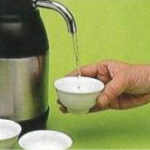
STEP1. Cool hot water to appropriate temperature
Pour hot water up to eight tenths of teacups prepared for each person and then let it cool. When hot water is poured into a teacup from a pot, the temperature will fall by approximately 5℃ to 10℃. As a guide, tea should be cooled down to the following temperatures.


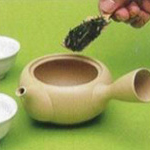
STEP2. Prepare enough tea leaves for each person
Add enough tea leaves into the teapot for each person (2 to 3g per person). However,
add slightly more when making tea for one person (about 5g) and less when making tea for five or more people (2g per person).
*One tablespoon is about 5g.
It would be useful to weigh in advance the weight of one teaspoon of the tea you regularly drink.
*One tablespoon is about 5g.
It would be useful to weigh in advance the weight of one teaspoon of the tea you regularly drink.

STEP3. Don’t rush and let the tea steep slowly
Pour the cooled hot water into the teacup and wait about 1 minute for normally steamed tea and about 30 seconds for deeply-steamed tea.
Best timing to pour the first infusion is when the tea leaves have unfolded itself to 60 to 90 %.
Best timing to pour the first infusion is when the tea leaves have unfolded itself to 60 to 90 %.
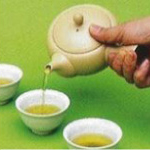
STEP4. Pour-round the equal amount of tea into each tea cups little-by-little.
Pour the tea little-by-little into each person’s teacup over several times.
This is called “pouring round”, where tea is poured in order of “1, 2, 3” and then back “3, 2, 1”, which is subsequently repeated.
By doing so, the flavor and quantity is distributed evenly. Straining the tea until the final drop is vital.
This is called “pouring round”, where tea is poured in order of “1, 2, 3” and then back “3, 2, 1”, which is subsequently repeated.
By doing so, the flavor and quantity is distributed evenly. Straining the tea until the final drop is vital.
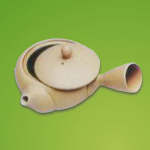
STEP5. Enjoying the second infusion of tea
Be sure to pour out all the tea in the teapot. Then leave the lid slightly ajar and let the heat inside escape.
Allowing the tea leaves inside to over-steam will dilute the taste of the second infusion.
Pour the tea about 10 seconds after pouring the hot water at a slightly higher temperature than the first infusion.
Allowing the tea leaves inside to over-steam will dilute the taste of the second infusion.
Pour the tea about 10 seconds after pouring the hot water at a slightly higher temperature than the first infusion.
Can you tell me about origin labeling requirements?
Until April, 2003, no origin labeling standards had been designated. As soon as this observation had been made, our former chairman announced a standard whereby “Maruzen has laid down its roots in Shizuoka, so it is only natural that the label of origin should show 100%.(Not to disgrace the name of best tea producing region “Shizuoka”) In accordance with customers’ requests, we shall only provide tea that has been made 100% in the relevant region”.
We have a strict policy on origin labeling requirements even for products produced outside of Shizuoka but finalized in Shizuoka. *A clear-cut standard on origin labeling requirements announced by the Japan Tea Central Association in April, 2004 was that “only crude tea that is 100% produced in the same region shall be shown as that particular prefecture/city/region’s tea (e.g. Shizuoka tea), while if it is over 50% but less than 100% it shall be shown as that particular prefecture/city/region’s “BLEND” (e.g. Shizuoka and Kanagawa blend).
(According to Japan Tea Central Association “Green Tea Label Standard”)
We have a strict policy on origin labeling requirements even for products produced outside of Shizuoka but finalized in Shizuoka. *A clear-cut standard on origin labeling requirements announced by the Japan Tea Central Association in April, 2004 was that “only crude tea that is 100% produced in the same region shall be shown as that particular prefecture/city/region’s tea (e.g. Shizuoka tea), while if it is over 50% but less than 100% it shall be shown as that particular prefecture/city/region’s “BLEND” (e.g. Shizuoka and Kanagawa blend).
(According to Japan Tea Central Association “Green Tea Label Standard”)
Where are the main tea-producing regions?
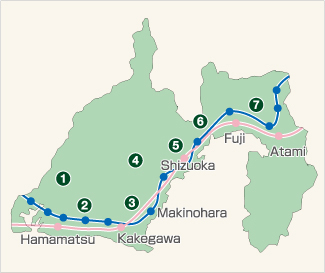 Shizuoka is a well-known tea-producing region. Many of the most well-known tea producing regions in Shizuoka are situated along river basins. Many tea wholesalers are located in Anzai, Aoi ward, Shizuoka City, and the whole city is filled with the rich fragrance of new tea leaves during the first tea of the season. We will now introduce the most well-known tea producing regions in Shizuoka starting from the west of Shizuoka.
Shizuoka is a well-known tea-producing region. Many of the most well-known tea producing regions in Shizuoka are situated along river basins. Many tea wholesalers are located in Anzai, Aoi ward, Shizuoka City, and the whole city is filled with the rich fragrance of new tea leaves during the first tea of the season. We will now introduce the most well-known tea producing regions in Shizuoka starting from the west of Shizuoka.
1. Tenryu / Haruno / Mori tea-producing region
TTea fields extend along mountain streams around the Ota and Tenryu rivers in the west side of the prefecture.
2. Chuen tea-producing region
This region is mainly made up of tea fields that border the Mount Ogasa area and Makinohara, and it also includes the Iwatahara plateau.
This region has many tea fields on hilly areas and it has been known as the producing area for “Fukamushi-cha &*Tokumushi-cha (Deeply steamed tea & Extra deeply steamed tea) for many years.
*Tokumushi-cha(Extra deeply steamed tea) – Just picked tea leaves are steamed longer than fukamushi-cha (deeply steamed tea)
(Tokumushi-cha is also known as gokumushi-cha).
This region has many tea fields on hilly areas and it has been known as the producing area for “Fukamushi-cha &*Tokumushi-cha (Deeply steamed tea & Extra deeply steamed tea) for many years.
*Tokumushi-cha(Extra deeply steamed tea) – Just picked tea leaves are steamed longer than fukamushi-cha (deeply steamed tea)
(Tokumushi-cha is also known as gokumushi-cha).
3. Makinohara tea-producing region
The Makinohara tea field is a large tea field that extends along the extensive western bank of the Oi river in central Shizuoka.
At the beginning of the Meiji era, it was developed by vassals of the Tokugawa Shogunate and professional fording coolies. While Makinohara was at the time a deserted barren land, today it is a vast tea field and the largest tea-producing area in Shizuoka Prefecture.
National and Prefectural Tea Research Stations are located here.
At the beginning of the Meiji era, it was developed by vassals of the Tokugawa Shogunate and professional fording coolies. While Makinohara was at the time a deserted barren land, today it is a vast tea field and the largest tea-producing area in Shizuoka Prefecture.
National and Prefectural Tea Research Stations are located here.
4. Kawane tea-producing region
In the Kawane region, there are tea fields on the slopes of mountains along the upper river basin of the Oi river which has its source in the South Japanese Alps.
It has been recognized throughout Japan for many years as a premium tea-producing region thanks to its favorable location; wrapped in gentle morning mist; and to the hard work of its farmers.
It has been recognized throughout Japan for many years as a premium tea-producing region thanks to its favorable location; wrapped in gentle morning mist; and to the hard work of its farmers.
5. Honyama tea-producing region
This is a production region centered around the Abe river that flows through Shizuoka city, and the upper river basin is called Honyama where high-quality tea is produced.
It has a long history of producing tea with distinctive characteristics.
It has a long history of producing tea with distinctive characteristics.
6. Shimizu and Ihara tea-producing region
This is a production region centered around the nihon-daira plateau and the Okitsu river basin in Shimizu ward (formerly Shimizu city) in Shizuoka city. The tea fields in this region extend along mountain slopes.
7. Fuji and Numazu tea-producing region
Tea fields in this region extend along the broad area to the southwest of Mount Fuji and the hilly terrain in the southern face of Mount Ashitaka.
It only has a short history of cultivating tea, but uses modern cultivation methods.
It only has a short history of cultivating tea, but uses modern cultivation methods.




